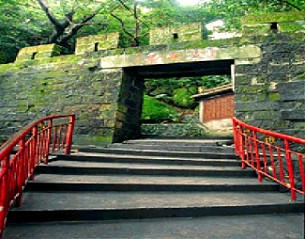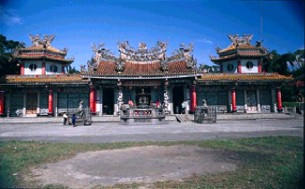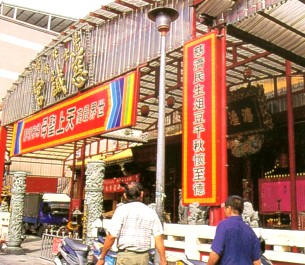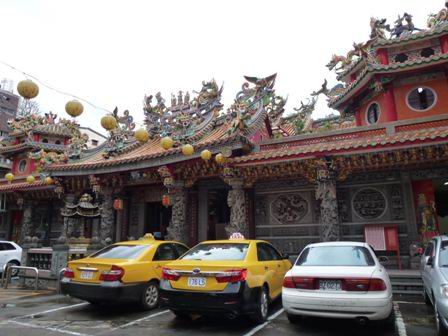Chin Shan Yen Prehistoric Site
In ancient times, Chih Shan Yen was an islet in the lake that filled the Taipei Basin. During the Japanese colonial period (1895-1945), archaeological remains were found at Chih Shan Yen, making it the first archaeological site in Taiwan. Archaeological research has revealed remains from two prehistoric cultures – the Chih Shan Yen culture and the Yuanshan culture. The remains of the Yuanshan culture can be seen on the side slopes and the top of Chih Shan Yen, and along the sides of Zhicheng Road and Yusheng Road. Archaeological remains from the Chih Shan Yen culture can only be seen between Yu Nong Elementary School and the Stone Deity Shrine in the northwest corner of Chih Shan Yen. Compared to other prehistoric cultures of Taiwan, the Chih Shan Yen culture has yielded a rich variety of excavated cultural artifacts, including ceramics, stone, bone and shell products, as well as rice, woven grass, wooden utensils and other objects indicative of an advanced culture.

Chin Shan Yen Gate
Built in 1825, Chih Shan Yen Gate is a remnant of armed conflict between two communities of immigrants from the Fujian province regions of Zhangzhou and Quanzhou. Made of locally quarried stones, the gate was a defensive construction of the people from Zhangzhou. The top of the wall was crenellated, with openings through which weapons could be fired. The original fortification included four gates, positioned east, west, north and south, of which only the west gate is extant. Inside the gate lie the Huiji Temple and a funerary temple. The rock outside the gate is inscribed with four Chinese characters by noted Qing dynasty scholar Pan Yongqing, depicting the enchanting beauty of Chih ShanYen.

Huiji Temple, Zhishanyan
Built between 1752 and 1764, Huiji Temple is dedicated to the worship of the Sage King Chen Yuanguang, founder of the Zhangzhou district of Fujian. Rebuilt five times since its original construction, the current structure dates from 1968. It is made predominantly of concrete, inlaid with stone sculptures from older generations of the temple. The front hall is dedicated to the Sage King Chen Yuanguang, the upper floor of the rear hall honors the god of scholarship Wen Chang, and the lower hall is dedicated to the Buddhist deity Avalokiteshvara.
In 1786, rebel military leader Lin Shuangwen rose up against the Qing dynasty authorities, attacking Zhishan. The incident resulted in the massacre of many Shilin locals near the Huiji Temple. A tablet erected here commemorates the fallen.
Other architectural remnants from the early settlement in Shilin, such as the Zhishan Huaigu Pavilion, a tablet attesting to the donation of the grounds, a narrow gate originally part of fortifications, and a funerary temple, remain in the vicinity.

Cixian Temple, Shilin
Cixian Temple, dedicated to the worship of the goddess Matsu, was originally built in 1796 near the current location of the Taipei American School in Shilin. In 1864, a group of devotees, including Pan Yongqing and Pan Shengqing, constructed a new temple on New Bazhilan Street to provide a guardian deity for the area. The temple was rebuilt in 1927. Artisans of two different schools constructed the left and right sides separately, resulting in carvings of different styles. The exquisite koji ceramic art in the main hall is also a significant feature.

Grass Mountain Royal Guest House
"Grass Mountain" is the name by which the Yangmingshan area was formerly known. During the Japanese colonial era, it was developed into a new recreational district due to its excellent hot springs and superb mountain scenery. In April 1923, when Japan’s Crown Prince Hirohito toured Taiwan, the colonial administration selected Grass Mountain as one of the points of interest on his itinerary, and the Grass Mountain Royal Guest House was built especially to serve as his personal lodging. Situated in a secluded and quiet mountain valley, the building’s architectural style shows a unique mixture of Japanese and Western influences.
After World War II, the Grass Mountain Royal Guest House became known as Yangmingshan First Guest House, hosting confidential meetings of the Chinese Nationalist Party. Converted to a residence, it subsequently housed Sun Ke, president of the Examination Yuan, and descendants of ROC founding father Dr. Sun Yat-sen.

Shilin Shennong Temple
Shilin Shennong Temple was first constructed as Fude Ci (Fude Shrine) in the 48th Year of Emperor Kangxi of the Qing Dynasty (1709 CE) at Shulin Zhuang (Shulin Village). A flood that took place during the 6th Year of Emperor Qianlong of the Qing Dynasty (1741 CE) forced the Shrine to relocate to the current location (modern day Jiujia Village), and granted it a new name of Zhilan Temple. During the 17th Year of Emperor Jiaqing of the Qing Dynasty (1812 CE), the temple was renamed as Shennong Gong (Shennong Temple) as the main deity of worship became Great Emperor Shennong. This Temple was the earliest religious building at the old boulevards of Shilin.
Shilin Shennong Temple was built by emigrants from Zhangzhou, making it an important center of Zhangzhou settlements as pioneers settled and developed the Taipei Basin and Shilin areas. The Temple was also an important base of operations during large scale armed conflicts between settlers from Zhangzhou and those from Quanzhou. Shilin Shennong Temple is one of the 3 ancient temples alongside Cicheng Temple and Huiji Temple. All 3 temples share strong, inseparable historical ties, with Shilin Shennong Temple being the first to be constructed in the region. These temples also formed the earliest religious district in the Shilin area, witnessing the earliest stages of urban development in Shilin from its address at the old Shilin boulevard.
Shennong Temple has been rebuilt and refurnished on multiple occasions, with reinforced concrete (RC) being used to construct the Sanchuan Dian (Three Rivers Hall) and Zhonggu Lou (Bell and Drum Tower) in 1972 and rebuilding the main hall as a 2-story RC building in 1993. Nevertheless, dragon pillars, stone beams, carved stone windows, steles, documents, and other historical artifacts and architectural elements have been preserved, serving as key evidence proving the extended history of the Temple.

Zhishanyan Xuetang
Shilin Elementary School used to be Zhishanyan Xuetang (Zhishanyan School) that was first established in Kaizhang Shengwang Miao (Temple of the Holy Prince Founder of Zhangzhou). The School was the first educational institution established in Taiwan during the earliest stages of Japanese Occupation (1895) and was later renamed as the First Extension of the Japanese Language School and Bazhilan Public School. Bazhilan Public School was relocated to this place after the new school building was established in 1904. This brick school building was constructed in 1916 (the 5th Year of the Japanese Emperor Taisho) and is now the only campus building dating from the Japanese Occupation. The building is a testament to the century-long history of Shilin Elementary School and is extremely important in the history of education in Taiwan.
The school building features a red-brick architectural form that was popular during the reign of Emperor Taisho of Japan. The architectural body, arched windows, flying buttresses, and stages of the original building have been preserved, making the school building extremely meaningful in a historical sense. A door post from the preceding Bazhilan Public School was placed in front of the lecture hall. This feature is also an extremely important historical artifact for the school campus.

![Taiwan.gov.tw [ open a new window]](/images/egov.png)
